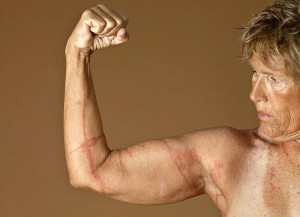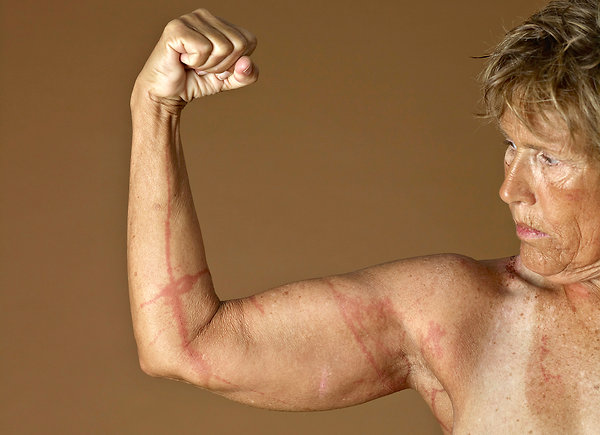
Photo by Catherine Opie
Yesterday when I read that Diana Nyad had finally succeeded in her quest to swim from Cuba to Florida, my first reaction was “but at what cost?”
Nyad completed the 100 to 110 mile swim from Cuba to Florida in almost fifty three hours of continuous swimming. She is the first woman[1] to complete this feat without a shark cage. This may seem like only a safety concern, but when swimming in a shark cage, the swimmer benefits enormously from the drag or current in the water created by the boat towing the cage. Nyad had a large support team including a team of shark divers who swam ahead of her with shark repellants and a support boat which she did not hold on to at any time. It was her fifth attempt at the swim. The first attempt was in 1978. Diana Nyad is 64 years old.
It’s an inspirational story of age and determination overcoming youth and vigor. Nyad herself said when she reached the shore:
“I have three messages. One is we should never, ever give up. Two is you never are too old to chase your dreams. Three is it looks like a solitary sport, but it takes a team.”
President Obama congratulate her on twitter, “Congratulations to @DianaNyad. Never give up on your dreams.” Terry Savage of the Huffington Post proclaimed Nyad a hero who reminds us to “never give up” and that “persistence pays.” So why was my reaction “but at what cost?”
My reaction was informed by memories of a New York Times magazine article I read about Nyad in 2011, shortly before her fourth attempt. The author, Elizabeth Weil, did a wonderful job of characterizing Nyad and her quest. What stuck with me was the relationship between Nyad and one of her friends and lead handler, Bonnie Stoll:
Whatever the case, in early November Stoll decided she could no longer abide Nyad’s “Groundhog Day”-like optimism. If she was going to discuss another swim with Nyad — let alone, train her for one — Stoll needed Nyad to watch a video of her jellyfish stings. So one Wednesday morning, Stoll drove over to Nyad’s house, where Nyad’s nephew, who’s making a documentary about his aunt’s swimming, cued up a six-minute clip. The two women sat close on the couch, hunched toward the laptop on the coffee table. The footage was gruesome. Gone was the swimmer’s strong, confident, singing, counting athletic self. Nyad’s eyes looked desperate, terrified. “Wow wow wow,” she said on the video, treading water, trying to manage her pain. “Are we all the way across?” she asked, attempting to orient herself. “This can’t be all the way across.” Back on the couch, Stoll flinched. Nyad’s eyes teared up. The body in the water — Nyad’s body — was going into shock. “It’s under my arm, the armpit. . . . It’s paralyzing my back.” Stoll’s voice on the laptop strained for control. “Diana in, out. Diana in, out! Breathe!”
For a few moments after the video ended, Nyad seemed cowed. “That’s the first time I’ve seen what you were living through,” she said to Stoll, wiping away a tear. “I look like a child who is scared.”
But five minutes later that fear was gone. Nyad has a rare gift: muscles and a psyche that can swim for days straight.
We sports fans celebrate the outliers. Diana Nyad has rare gifts that allow her to swim and swim and swim, forgetting past failure and current pain. We marvel at how Michael Jordan could overcome the flu (or food poisoning… or a horrible hangover depending on who you ask) to score 38 points in 44 minutes during the 1997 NBA finals. We lionize “genius” coaches like Mike Leach whose eccentricities are matched only by their winning.
Nyad’s, Jordan’s, and Leach’s performances are all admirable and inspiring, but is there a necessary downside to athletic achievement? Jordan competitive drive led him to gamble compulsively and psychologically terrorize his lesser teammates.[2] Leach’s try anything attitude ended his employment at Texas Tech when he ordered a concussed player to stand in a dark closet. When Nyad walked up the beach in Key West, Bonnie Stoll was there to hug her but I have to ask: Was it worth it? What was the cost of success for her life? For her friend’s life?

